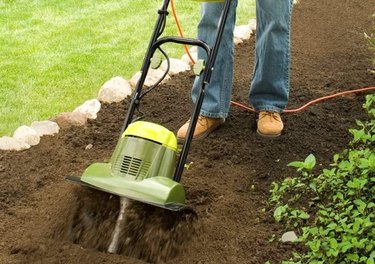Tillers can be effective tools in a home garden, but their use is usually infrequent, so you may be better off renting a tiller rather than purchasing one. Depending on your area and the vendor from which you will be renting, the cost will vary.
Renting vs. Owning a Tiller
Video of the Day
If you have a back 40 and you regularly expand your garden to add new beds, owning a tiller makes sense. But this is an expensive machine not to mention a large one, so you'll need to have a shed or garage to store it when not in use. It's possible, however, to find a small electric tiller in the neighborhood of $100 or so if you do think you'll get more regular use out of it.
Video of the Day
For most gardeners, however, borrowing or renting a tiller makes more sense. You just hop down to a local rental shop, load the tiller into your vehicle, bring it home, and do the deed. You don't have to worry about maintenance or storage. There are no repair bills and no headaches. If it doesn't work, it's someone else's problem. You do, however, have to consider the size of your vehicle and the size and weight of the tiller to make sure you can get it in and out of your car safely.
Some rental companies may offer delivery and pickup if your vehicle isn't large enough, so be sure to do your research before you commit.
Types of Tillers to Consider
First off, how much area do you need to till? Various sizes of tillers are usually available, from light-duty types that might be called "mini-cultivators" to heavy-duty, tow-behind tillers. The mini-cultivators are generally designed to aerate the soil in existing beds and are effective at dislodging weeds. These are usually two-cycle gas engines or electric, either corded or cordless. Some gardeners also use them to remove sod.
The next size up is rototillers that you walk behind, which is probably what you think of when you think of a tiller. If you're creating a new bed (i.e., breaking new ground), these are the ticket. But they do vary widely. Some have front tines that are stronger than mini-cultivators but are not designed to break up rocky or very hard, compacted soil. Some are designed with tines positioned directly beneath the engine, which makes them more balanced. If you have a very large project or your soil is heavy, you'll want a tiller with rear tines, which are designed for heavy-duty use.
Finally, there are rototillers that are designed to be pulled behind tractors or ATVs. It's unlikely this is what you are looking for unless you have a farm.
Further, most tiller tines range in size from 12 inches to 24 inches wide. They can also be used as cultivators to remove weeds, so if you want to use them in garden paths, you probably want a smaller one.
The Cost of Renting a Tiller
Obviously, the cost of renting a tiller will vary depending on the vendor and your location. Most experts peg the cost at somewhere between $60 and $250 per day depending on the size (not including the tow-behind tillers). For example, average current prices at Home Depot for a light-duty tiller are $60 per day, while its heaviest-duty tiller is around $170 a day. If you need it for an extended project, be sure to ask about weekly rates, which can save you a lot of money especially if you can share the cost with a friend or neighbor.
Many home improvement stores rent gardening equipment, as do hardware stores, equipment rental shops, and lawn mower shops. Do some research to determine the best prices and availability of the type of tiller you need before heading out to rent one.
